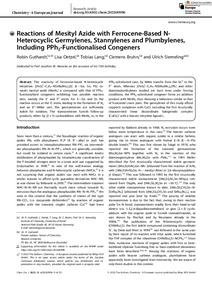| dc.date.accessioned | 2022-08-11T13:11:33Z | |
| dc.date.available | 2022-08-11T13:11:33Z | |
| dc.date.issued | 2022-05-05 | |
| dc.identifier | doi:10.17170/kobra-202207286541 | |
| dc.identifier.uri | http://hdl.handle.net/123456789/14046 | |
| dc.description.sponsorship | Gefördert im Rahmen des Projekts DEAL | ger |
| dc.language.iso | eng | |
| dc.rights | Namensnennung 4.0 International | * |
| dc.rights.uri | http://creativecommons.org/licenses/by/4.0/ | * |
| dc.subject | azides | eng |
| dc.subject | carbene homologues | eng |
| dc.subject | metallocenes | eng |
| dc.subject | subvalent compounds | eng |
| dc.subject | tetrylenes | eng |
| dc.subject.ddc | 540 | |
| dc.title | Reactions of Mesityl Azide with Ferrocene-Based N-Heterocyclic Germylenes, Stannylenes and Plumbylenes, Including PPh₂-Functionalised Congeners | eng |
| dc.type | Aufsatz | |
| dcterms.abstract | The active PbII/P Lewis pair nature of a PPh₂-functionalised ferrocene-based N-heterocyclic plumbylene is demonstrated by its reaction with mesityl azide to afford a phosphazide, which is in contrast to the inertness of the unfunctionalised congener. The lighter analogues most likely react with MesN₃ at their respective tetrel atom Eᴵᴵ, leading to the formation of N₂ and an Eᶦᵛ=NMes unit, followed by NMes transfer from the Eᶦᵛ to the Pᴵᴵᴵ atom.
The reactivity of ferrocene-based N-heterocyclic tetrylenes [{Fe(η⁵−C₅H₄−NSitBuMe₂)₂}E] (E=Ge, Sn, Pb) towards mesityl azide (MesN₃) is compared with that of PPh₂-functionalised congeners exhibiting two possible reaction sites, namely the Eᴵᴵ and Pᴵᴵᴵ atom. For E=Ge and Sn the reaction occurs at the Eᴵᴵ atom, leading to the formation of N₂ and an Eᶦᵛ=NMes unit. The germanimines are sufficiently stable for isolation. The stannanimines furnish follow-up products, either by [2+3] cycloaddition with MesN₃ or, in the PPh₂-substituted case, by NMes transfer from the Snᶦᵛ to the Pᴵᴵᴵ atom. Whereas [{Fe(η⁵−C₅H₄−NSitBuMe2)2}Pb] and other diaminoplumbylenes studied are inert even under forcing conditions, the PPh₂-substituted congener forms an addition product with MesN3, thus showing a behaviour similar to that of frustrated Lewis pairs. The germylenes of this study afford copper(I) complexes with CuCl, including the first structurally characterised linear dicoordinate halogenido complex [CuX(L)] with a heavier tetrylene ligand L. | eng |
| dcterms.accessRights | open access | eng |
| dcterms.creator | Guthardt, Robin | |
| dcterms.creator | Oetzel, Lisa | |
| dcterms.creator | Lang, Tobias | |
| dcterms.creator | Bruhn, Clemens | |
| dcterms.creator | Siemeling, Ulrich | |
| dc.relation.doi | doi:10.1002/chem.202200996 | |
| dc.subject.swd | Azide | ger |
| dc.subject.swd | Chemische Synthese | ger |
| dc.subject.swd | Eisenkomplexe | ger |
| dc.subject.swd | Chemische Reaktion | ger |
| dc.subject.swd | Staudinger-Reaktion | ger |
| dc.subject.swd | Carbene | ger |
| dc.type.version | publishedVersion | |
| dcterms.source.identifier | eissn:1521-3765 | |
| dcterms.source.issue | Issue 42 | |
| dcterms.source.journal | Chemistry - a European journal | eng |
| dcterms.source.volume | Volume 28 | |
| kup.iskup | false | |


